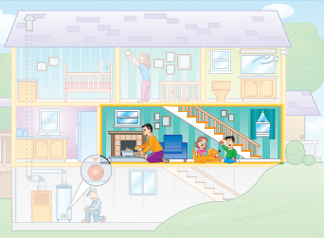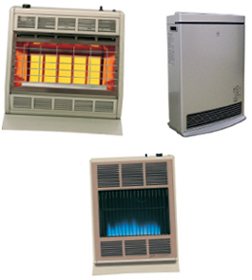
With such purchases comes the need for assurances that such products are safe, especially since most are in home situations. And such assurances come from a variety of sources, such as independent testing, a myriad of code requirements, and, at the heart of such units, the Oxygen Detection Safety (ODS) pilot.
The selling point for such vent-free gas appliances includes energy efficiency, convenience, and, in the case of gas logs or fireplaces, there's no need for wood. There is a wide range of products, including space heaters, gas stoves, gas fireplaces, gas fireplace inserts, and gas logs that can be installed within existing masonry or factory-built fireplace. Locations could include living rooms, kitchens, family rooms, dining rooms, home offices, playrooms, basements, garages, room additions, sun porches, or recreation rooms.

"With any appliance other than vent-free, it takes quite a while to build up heat in a room. A vent-free heater or log set provides heat immediately," he said. "We've found this is a key point for our customers, along with the 99 percent efficiency of vent-free appliances."
Because a chimney is not needed, a vent-free gas product can be installed almost anywhere, even along an inside wall.
"In contrast, installing a traditional wood fireplace is a major and costly construction project," noted Mary Carson, program director for the Vent-Free Gas Products Alliance. "With a vent-free gas fireplace or heater, you have complete flexibility in designing or redesigning your room. A vent-free supplemental gas product can reduce heating costs by allowing you to zone heat. You can use your vent-free unit to provide abundant heat for the rooms in most frequent use, and turn down your central heating thermostat."
THE SAFETY FACTOR
The building codes in the United States require that all gas appliances, including vent-free gas products, be approved to specific safety standards that are approved by the American National Standards Institute (ANSI). For vent-free gas appliances, the standard is ANSI Z21.11.2. The building inspector and gas utility will look for the metal label listing the testing laboratory that certified the product. The performance tests in the standard ensure that, under normal and certain abnormal conditions, the combustion is within safe limits and that no part of the appliance exceeds safe temperature limits, among other safety-related design and performance items.Among the safety issues that the vent-free industry addresses with its products are those concerning carbon monoxide (CO) and moisture (H20), since both are byproducts of gas combustion. The effects of vent-free products' emissions on sensitive populations were tested in an extensive independent study on indoor air quality (IAQ) - and the results were favorable.
"This research used as its criteria the recommended maximum levels of CO as set by the Consumer Product Safety Commission (CPSC) with sensitive populations - such as children, pregnant women, and the elderly - as the benchmark," said Carson. "The results of the research proved that vent-free gas heating products performed well within the CPSC guidelines for carbon monoxide."

To address the moisture issue, the industry recommends adequate ventilation.
"If the home shows symptoms of inadequate ventilation, such as moisture on the insides of windows and mildew, more ventilation may be required prior to adding additional vent-free gas appliances," said Carson. "Also, if the vent-free product is installed in a tight new home, the installer should make sure a home is properly ventilated."
For the vast majority of homes in the United States, Carson noted that vent-free gas heating products do not generate enough water vapor to raise indoor humidity levels high enough to foster mold growth.
KEEPING UP WITH CODES
All model codes and code groups permit the installation of vent-free gas products, including the National Fire Protection Association (NFPA), Building Officials and Code Administrators (BOCA), Southern Building Code Congress International (SBCCI), Council of American Building Officials (CABO), International Mechanical Code (IMC), International Fuel Gas Code (IFGC), International Residential Code (IRC), and the Uniform Mechanical Code (UMC). The International Association of Plumbing and Mechanical Officials (IAPMO) sponsored UMC accepted vent-free appliances as of January 2006 and is currently being adopted in their code regions. Forty-nine states in the United States allow for the sale and installation of vent-free supplemental gas heat appliances.
ODS AND OTHER SAFETY FEATURES
U.S. manufacturers of vent-free gas products adopted oxygen detection safety (ODS) pilot technology in the early 1980s. The technology originated in Europe more than 50 years earlier and had a solid track record of safety, according to those in the industry."The ODS pilot is a proven safety device. There are literally millions of vent-free gas products in use in the United States, and not one has been involved in a CO incident," said David Knowles, manager of technical services for the Gas Appliance Manufacturers Association (GAMA).
An oxygen depletion safety shutoff system consists of three main components:
1. An oxygen-sensitive pilot burner;
2. A thermopile, positioned in the pilot flame; and
3. A safety shut-off valve.
The pilot is designed to be stable within a narrow-operating range. The thermopile, when heated, generates a small current that keeps the gas supply valve in the open position. If the level of oxygen drops, the flame starts to go out. The loss of flame causes the thermopile current to drop to the point where it cannot keep the gas valve open. The main fuel supply to the appliance closes, and the appliance is safely shut off. The unit will not operate until the living space is properly ventilated, adequate oxygen is introduced, and the appliance is restarted.
As a further check-and-balance, ODS systems contain orifices designed to disintegrate with any attempt at drilling them out to enlarge the pilot flame. The product is not interchangeable with a normal standing pilot. Further, propane and natural gas vent-free products cannot be converted from one type of gas to another.
Beside the ODS, most vent-free heating appliances also have:
SALES GROWTH
The various ways the industry has addressed safety questions, combined with installation and energy savings components, have allowed for a growing market for vent-free products with more than 17 million units now being used in the United States."Our sales of vent-free appliances have grown tremendously in the last five years," said Susan Scott of O'Malia's Fireplace Shop (Carmel, Ind.) "The approach provides an opportunity to add a fireplace or heating system to a room or garage and not be concerned with the need to install a vent or chimney.
"That's a huge cost-savings."
For more information, visit www.ventfree.org.
Publication date: 07/24/2006

Report Abusive Comment